Jiangsu deputy keeps millennia-old Suzhou embroidery up to the times
Yao Jianping, a passionate artist and a deputy to the 14th National People's Congress (NPC), has dedicated nearly 50 years to Suzhou embroidery, one of the oldest embroidery techniques in the world and a quintessential type of Chinese embroidery.
With a simple needle moving rhythmically across fabric, Yao breathes life into fabric and threads, creating works Infused with cultural heritage and the spirit of the times.
Yao, a national intangible cultural heritage inheritor, is widely recognized for her unique style of the art featuring elegant patterns, ingenious designs, exquisite needlework, clever stitches and graceful colors.
Driven by a commitment to innovation and a desire to align with contemporary trends, she has enabled this traditional fine art to reach a wider audience.

Yao Jianping, a deputy to the 14th National People's Congress from Suzhou city in East China's Jiangsu province, poses for a photo with her works. [Photo provided to npc.gov.cn]
Yao said that art should reflect the pulse of societal development and capture the essence of contemporary culture.
Through her work, Yao depicts the concept of "embroidery evolving with the times," using Suzhou embroidery as a medium to support the country's diplomacy, promote people-to-people ties, reflect the beauty of life and tell China's stories to the world.
By breaking free from traditions and embracing innovation, Suzhou embroidery can exude a more captivating artistic allure, she said.
As a vital component of traditional Chinese culture, Suzhou embroidery shines brightly in the vast expanse of China's cultural heritage. As tourism industry thrives, the revitalization and creative transformation of intangible cultural heritage has become both culturally significant and economically promising.
As a deputy, Yao cares most about the preservation and development of intangible cultural heritage. "During my grassroots field research, I found that tourism market's development of embroidery lacks direction and suffers from insufficient integration," she said.
Through collaboration with a research center at Nanjing Normal University, she gained insights into the challenges faced by artisans in transforming their works into tourism products, such as limited product-market fit and underdeveloped sales channels.
Her meticulous fieldwork and observations of how intangible heritage products are displayed in popular tourist destinations, coupled with feedback from tourists, prompted Yao to make suggestions on strengthening standardization for integrating intangible cultural heritage with tourism at the annual NPC session in 2024.
"I suggested the establishment of an expert pool to provide technical guidance, formulating standards for the use of the intangible cultural heritage logo in the tourism industry and revising the Regulations on the Management of China Intangible Cultural Heritage Label, aligning it with national efforts in cultural and tourism standardization," she said. Her suggestion was eventually included among the key suggestions prioritized by the NPC Standing Committee in 2024 and followed up by the Ministry of Culture and Tourism.
At this year's NPC session, Yao put forward multiple suggestions regarding promoting the high-quality development of the Chinese embroidery industry and advancing traditional Chinese embroidery techniques to be considered as candidate projects for inclusion in the Representative List of the Intangible Cultural Heritage of Humanity.
"Progress is now being made in the standardization of intangible cultural heritage, and relevant authorities are promoting the better integration of intangible cultural heritage with tourism," she said.
Li Xinyu and Xu Hang contributed to this story.
- Top legislature schedules session for December
- China's top legislator holds talks with president of Luxembourg parliament
- China's top legislator meets with French president
- China, Maldives pledge to enhance exchanges between legislative bodies
- Senior Chinese legislator meets Portugal's PSD delegation



